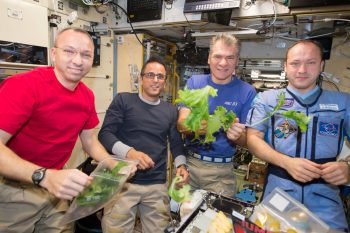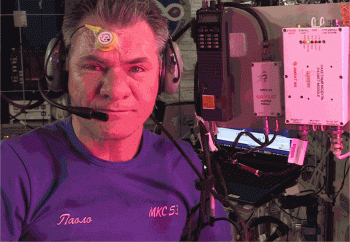Vita mission, ESA astronaut Paolo Nespoli’s third, is almost over! But the science that takes place on the International Space Station is continuous, even while Paolo and his colleagues worry about “packing up” for the trip back to Earth.
The past few weeks since our last blog post have been demanding but also full of surprises. The last Cygnus cargo resupply brought enough provisions and hardware to keep the crew busy and in good spirits.
When you really, really miss pizza… you CASUALLY mention it to the International @Space_Station Boss during a live public event ? Thank you Kirk for surprising us with unexpectedly delicious pizzas! #VITAmission pic.twitter.com/WstvG3IKr1
— Paolo Nespoli (@astro_paolo) December 2, 2017
Among all the science and supplies was a nice little surprise for Paolo and his five fellow astronauts: ingredients to make pizza! The crew spent an enjoyable evening making and eating their creations.
Does space pizza provide enough calories for astronauts? We will have to wait for the results of the Energy experiment, which has been collecting data on the energy expenditure of astronauts during long-term missions since 2012. Paolo started the study before leaving for the Space Station and once aboard provided measurements on his bone density and metabolism. Back on Earth, he will take measurements to compare the data and give researchers a clearer picture of what happens to our metabolism in space.

L’equipaggio con l’ultimo raccolto dell’esperimento Veg-03. Credit: ESA/NASA
If spaceflight and exploration is to venture beyond Earth orbit where the Space Station is, we need to know how many calories each astronaut needs to prepare for a successful journey.
Unfortunately, there will be no more pizza on the menu for the astronauts on the Space Station for the time being, but they are working to understand how to grow other types of food in space.
Thanks to NASA’s greenhouse located in the European laboratory Columbus, Paolo and colleagues are taking care of some plants as part of the Veg-03 experiment. This is the fourth harvest of this session and the first time a mix of different plants (lettuce, cabbage and mizuna) is grown in microgravity. In this phase of the experiment, only a small part of the harvest was reserved: samples of each plant and soil are inserted inside the MELFI freezer after each harvest, which operates at –80° Celsius, to preserve them until they can be sent back down to Earth for analysis. The goal is to understand if the process and the habitat in which the plants are growing is efficient and effective, with a view to grow them on longer space missions, during which the astronauts will need to grow their own food.
Lettuce is not the only thing that will grow on board the station. On board the next Dragon SpX-13 cargo spacecraft is the Arthrospira-B experiment, part of ESA’s Melissa programme. Arthrospira is a microalgae, known as spirulina, and is considered an interesting natural food supplement.
Once on board the experiment, it will be installed in Biolab, an incubator located in the European Columbus laboratory for biological experiments and which has recently been prepared for the arrival of the Arthrospira cultures.

Testing Perseo. Credit: ESA/NASA
But what use is space-farm-to-space-table meals if you are not protected from the harsh space environment during the long journey to another planet?
Among the many dangers that astronauts have to face is cosmic rays. This type of radiation is present throughout the Universe but here on Earth we are protected thanks to our atmosphere. How do we protect ourselves on board the Space Station or in a spacecraft to the Moon?
The PERSEO experiment, funded by the Italian Space Agency ASI, tackles this question. The experiment is testing a wearable jacket filled with water that would allow astronauts to continue their scientific and daily maintenance activities, even during solar storms when, for safety reasons, they are forced to take shelter in areas of the station with thicker walls (and therefore more protection). The jacket passed initials tests at the beginning of November, when Paolo filled it with water and wore it to test its practicality. As you can see from the photos, it seems convenient!
These are just some of the experiments that Paolo and his colleagues have performed in recent weeks; many other scientific and maintenance activities are carried out daily by the crew.
Another session of the ESA Airway Monitoring study was completed: like in our homes, the air on the Station carries microscopic dust particles that can cause respiratory inflammation. Using breath analysis, this experiment looks at the frequency and the type of inflammation: this knowledge will be put into practice in the future to improve conditions for long-duration missions to the Moon or Mars.
The astronauts also spent time testing new technologies that could help their daily work, such as augmented reality. In the ARAMIS experiment, the crew tested how an iPad and a video camera could support them in daily maintenance activities like searching for objects in the on-board inventory or moving objects from a starting position to a different position in the racks.
In addition to carrying out the experiments with the support of the ground control centres, Paolo and his colleagues are often also the subjects.
Experiments such as Sarcolab-3 (which studies the loss of muscle mass in microgravity) or Circadian Rhythms (which studies how experiencing 16 sunrises and sunsets per day affects the performance and health of astronauts) aim to understand how our bodies adapts extraterrestrial life and then applies this knowledge to future human spaceflight missions.
If all this information has given you a slight headache well, you’re not alone! Astronauts also have frequent headaches, which are monitored through a weekly questionnaire as part of the Space Headaches experiment.




Discussion: no comments